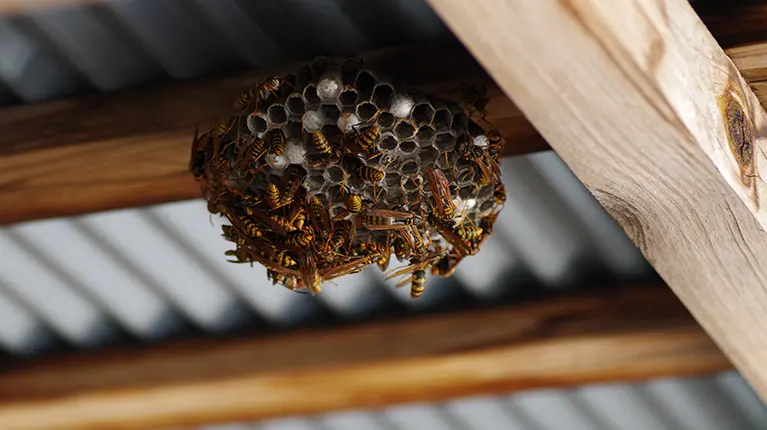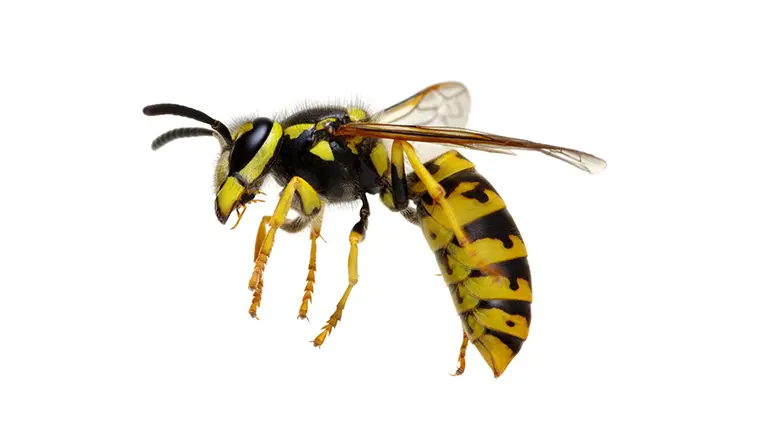Wasp disinfestation

The annoying noise and painful sting of the wasp leave no room for doubt: this is a dangerous pest that requires the expertise of a wasp disinfestation company.
The venom injected by the wasps' sting can trigger allergic reactions that pose some danger to humans.
Wasp disinfestation? It's time to call Truly Nolen!
The occurrence of invasive pests, such as the Asian wasp, is an environmental concern. This is because this wasp species directly attacks bees, preventing them from leaving their hives and invading their natural habitats. As bees are the main pollinators, this behaviour of Asian wasps has a strong impact on the ecosystem and on beekeeping.

How to identify a wasp
Wasps are often confused with bees or flies. To differentiate them, check out this information about wasp characteristics.
- They have two pairs of wings, unlike flies which only have one.
- They can sting several times during an attack, while bees die when they lose their sting.
- The yellow and black pattern differs from that of bees. The colors are more intense and the stripes more defined.
- Elongated body and thinner waist than bees.
- Smooth, shiny body with few hairs.
- Nests made of wood and chewed paper rather than wax.
- Smaller colonies, with about 1,000 wasps.
Why wasps appear
Wasps fly between yards and gardens in search of three essentials:
Shelter - To survive the winter and protect itself from predators, the wasp takes shelter in protected places such as in wall gaps, roof eaves, and insulation material.
Food sources - After hibernating in winter, wasps leave the nest to forage for food. It is advisable to ensure that gardens and backyards are cleaned by removing insects and food debris. If you enjoy barbecues and picnics, protect your ingredients and clean up the area immediately after eating.
Sugar - Avoid leaving fallen fruit from trees, soda cans, bird food, fruit juices, and anything else that is a good source of sucrose outdoors.
Flowers - Wasps are attracted to plants in blooming season and to strong perfumes. They enjoy the nectar and fragrance of flowers and can destroy garden beds.
Wasp species in Portugal
There are several species native to Portugal and it is not always necessary to carry out a professional wasp disinfestation. Learn how to distinguish between the different species.
The Asian wasp (Vespa velutina) is an invasive exotic species. It is easily identified by its black body between 17 and 32 mm, yellow-tipped legs, an orange stripe on the abdomen and orange head. It arrived in northern Portugal around 2011 and has been gradually advancing southwards, despite several containment measures by the responsible authorities.
In the adult stage, this wasp feeds on plant matter such as fruit. In the larval stage, however, they feed on large amounts of animal protein, specifically other insects and meat scraps.
The European wasp (Vespa crabro), has a predominantly yellow abdomen with black bands, yellow and red head, thorax and black and red legs. The workers measure between 18 and 23mm, and the queens between 25 and 35mm.
The Oriental wasp (Vespa orientalis) also measures between 18 and 35 mm. The abdomen has a yellow spot and the head is also yellow. It is present in southeastern Europe.
The Mammoth Wasp (Megascolia maculata) is one of the largest wasps in Europe. Its shiny black body is covered with a dense layer of hair. It has a yellow head on top and yellow hairless areas on the abdomen.
The Giant Madeira Wasp (Urocerus gigas) is a harmless wasp that lays eggs on tree trunks. Its larvae feed on the Mammoth Wasp. It has a black and yellow band, cylindrical body and the antennae are entirely yellow. The female can reach 45mm in length.
Wasp Disinfestation
Wasps prefer outdoor environments, but they can invade inhabited areas. They can nest in tree trunks, roofs, eaves, and cavities between walls.
A wasp's nest should not be attacked without professional help. On the one hand, partial destruction can cause the wasps to escape to other secondary nests. On the other hand, adequate protection is needed to avoid stings from wasps that feel threatened.
Do you have a wasp infestation? Contact an expert technician at Truly Nolen!
Learn more about all of our disinfestation services.